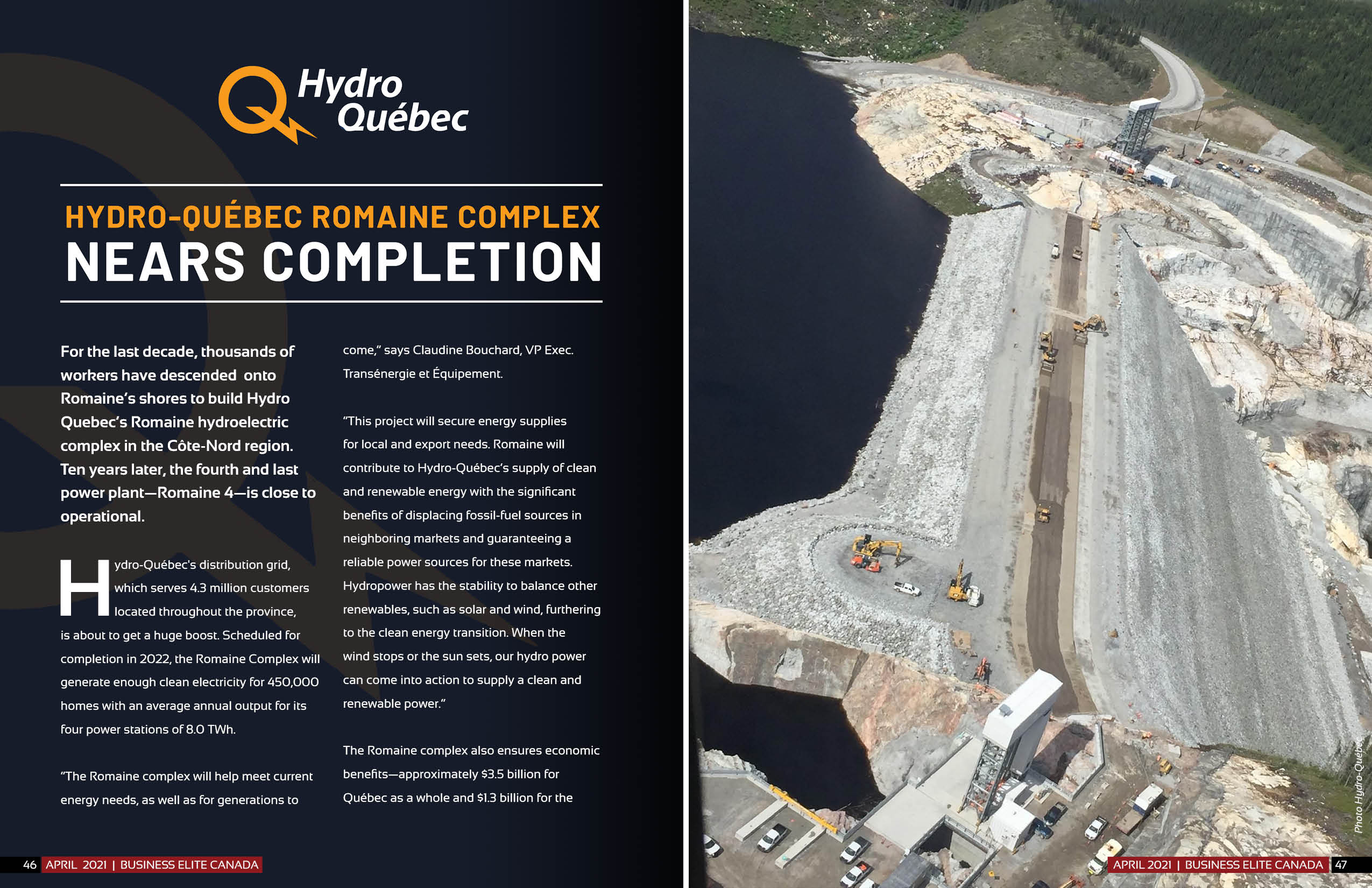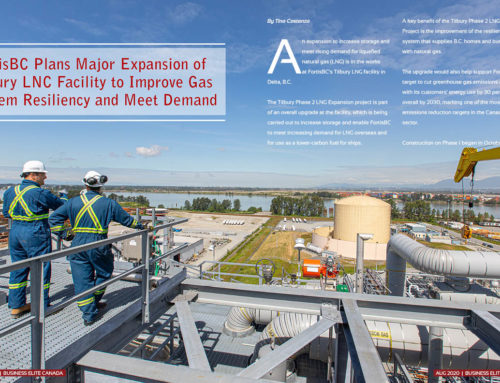For the last decade, thousands of workers have descended onto Romaine’s shores to build Hydro Quebec’s Romaine hydroelectric complex in the Côte-Nord region. Ten years later, the fourth and last power plant—Romaine 4—is close to operational.
Hydro-Québec’s distribution grid, which serves 4.3 million customers located throughout the province, is about to get a huge boost. Scheduled for completion in 2022, the Romaine Complex will generate enough clean electricity for 450,000 homes with an average annual output for its four power stations of 8.0 TWh.
“The Romaine complex will help meet current energy needs, as well as for generations to come,” says Claudine Bouchard, VP Exec. Transénergie et Équipement.
“This project will secure energy supplies for local and export needs. Romaine will contribute to Hydro-Québec’s supply of clean and renewable energy with the significant benefits of displacing fossil-fuel sources in neighboring markets and guaranteeing a reliable power sources for these markets. Hydropower has the stability to balance other renewables, such as solar and wind, furthering to the clean energy transition. When the wind stops or the sun sets, our hydro power can come into action to supply a clean and renewable power.”
The Romaine complex also ensures economic benefits—approximately $3.5 billion for Québec as a whole and $1.3 billion for the Côte-Nord region, host community of the project.
The Romaine complex will create clean, reliable, and renewable energy will be available to markets outside Quebec, aligning with the Québec government’s 2030 Plan for a Green Economy, a policy framework for electrification and the fight against climate change.
“The plan covers converting buildings to electricity, reinforcing transportation electrification and supporting conversion in other areas (industrial facilities, greenhouses, off-grid systems). With this plan, we forecast a 6.9 TWh growth in electricity use over 10 years,” says Bouchard.
Environmental Stewardship
Hydro-Québec created an Environment Department some 40 years ago, following the launch of the La Grande complex project. “Since then, we conducted numerous environmental studies on topics such as aquatic environments, wildlife and the human environment. For the Romaine complex, studies began before the 2000s and some will continue until 2040,” says Bouchard.
The objective of the long-term environmental monitoring program is to follow the evolution of the environment and effectiveness of mitigation, enhancement and compensation measures in order to make corrections if needed. In addition, these studies are a valuable source of information and contribute to a vast database which Hydro-Québec uses to assess the impacts of its projects.
Ongoing Environmental Monitoring
Hydro-Québec has been a pioneer in the study of greenhouse gas (GHG) emissions from hydropower reservoirs. Over the years, it has collected more than 500,000 measurements in lakes, rivers and reservoirs all over the province. “The world’s first Net GHG emission from the reservoir was done on Eastmain-1 and we are actually doing the same for La Romaine,” says Bouchard.
Bouchard explains that due to the very cold-water temperatures, high oxygenation and relatively small amount of suspended organic matter in boreal lakes, Hydro-Quebec reservoirs produce very little GHG, methane included. This explains why GHG emissions from Quebec hydropower generating stations are considerably lower (27 g CO2 eq/kWh) than those produced by thermal power plants (620 to 879 g CO2 eq./kWh) and of the same order of magnitude as those from nuclear and others renewables (22 to 247 g CO2 eq./kWh) based on a full life cycle analysis.
Ever since the early 1980s, Hydro-Québec has been conducting research programs on the mercury issue. Results show that mercury levels in modified environments are not harmful to populations of fish, birds and mammals that eat fish.
The impoundment of hydroelectric reservoirs leads to an increase in fish mercury levels for a period ranging from 10 to 35 years, depending on the fish species and reservoir characteristics. Hydro-Québec works continuously with public health authorities and communities to produce specific fish consumption guidelines.
Specifically, for the Romaine complex, monitoring of mercury in fish has begun and will continue up to 2039, in accordance with commitments. To date, the results follow the trends predicted in the environmental impact assessment.
First Nations Partnerships
Hydro-Québec’s objectives are also to develop sustainable, mutually beneficial partnerships based on respect of their values and cultures, says Bouchard.
“For the Romaine complex, Hydro-Québec signed three agreements with four First Nations. These agreements take into account their values, legal rights, and cultural and environmental concerns. It also enables the communities to actively participate in Hydro-Québec’s project and environmental monitoring program as well as benefit from the resulting economic benefits. The Innu communities of Ekuanitshit, Nutashkuan, Unaman-shipu and Pakua-shipi participated in the Innu studies by sharing, for example, their ecological knowledge,” says Bouchard. About 120 Innus from the region worked at the construction sites and 30 contracts were given to First Nations.
“This project is the latest hydroelectric complex under construction in Québec. Our government’s Plan for a Green Economy will bring a significant increase of domestic demand. We are focusing our efforts on reducing energy consumption provincially; we will soon be launching two new solar power stations which will help us better understand the potential for this energy source in Québec. And, further energy supplies will be added to our grid, namely from a First Nations windfarm project, Apuiat, in coming years.”
Energy Transition
Hydro-Québec has also launched a new subsidiary, EVLO Energy Storage Inc., a subsidiary that designs, sells, and operates safe, efficient and sustainable energy storage systems. Large scale energy storage can also be used to balance other renewables over a shot period and will play a crucial role in the energy transition. Bouchard says Hydro-Québec believe that the know-how Québec has acquired with regard to batteries will help develop our solar and wind power. “But we also believe hydropower, with its stability and reliability, will always be necessary.”
www.hydroquebec.com





